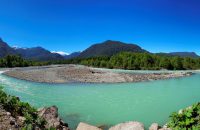Chile is a fantastic destination for any wine enthusiast. In Chile wine country is remarkably accessible, with many of the best vineyards located within a 100-mile radius of the capital, Santiago. Many of these wineries are steeped in history – for a New World producer, much of Chile’s vineyards have a strong sense of tradition. Vines were first brought to Chile by the Spanish in the 16th century. Later, wealthy Chilean wine-producers visited to France to refine their craft. Today, this rich history permeates Chilean wine-making, producing some of the world’s most delicious Merlots, Malbecs, and Sauvignon Blanc. Here, we run down a quick guide to Chile’s wine regions, vineyards, and wines.
Maipo Valley: Wine country on Santiago’s doorstep

In Chile wine country is right on the doorstep of the capital. In fact, the Maipo Valley is so close to Santiago that part of the city now reaches into the valley. Therefore, it’s possible to travel to your wine tasting tour by taxi. Once you’re in the valley, there are over 7000 acres of vineyards to explore. Most of these wineries produce Cabernet Sauvignons famous for their rich blackberry and cocoa notes. For instance, head to the historic winery Santa Carolina for a taste of Chile’s best-loved red. However, if white is more your things, head to the region’s coastal third, where you can try crisp Sauvignon Blanc.
Aconcagua Valley: Chile’s most surprising wine region
North of Santiago is the Aconcagua Valley, which produces a fantastic variety of delicious red wines, including Merlot and Syrah as well as national favorite Cabernet Sauvignon. The climate in the region is very changeable, with cold, wet winters and hot summers. At first, Chilean wine producers didn’t think it was the best place to grow grapes – however, in the 1870s, a man called Don Maximiano Errazuriz proved them wrong. After a long trip around Europe, Errazuriz returned to Chile and introduced state-of-the-art viticultural techniques to grow wine in the valley. Now, the Errazuriz winery is one of Chile’s most successful wine producers.
Cachapoal Valley: A slice of the Mediterranean in South America

The Cachapoal Valley is about 50 miles south of Santiago. The climate in the valley is very different from the regions to the north of the capital, as the mountains shelter the valley from coastal winds. This creates a climate more akin to the Mediterranean, with warmer, drier weather. Most of the region’s best wineries are on the slopes of the Andean mountains, shaded from the prevailing sunlight. Thanks to these conditions, the region produced some excellent red wines, the most notable of which is Carménère.
San Antonio Valley: The rising star of Chile wine country
To the southwest of Santiago is the San Antonio Valley, which produces some of the up-and-coming stars of Chilean wine. San Antonio is a cool climate region near to the ocean, which means the area’s wineries produce excellent Pinot Noir and Syrah. For example, one of San Antonio’s most famous Syrah producers is the Matetic winery, who began growing Syrah in 1999.
Casablanca Valley: Chile’s foggy wine region
The Casablanca Valley is another new addition to Chile wine country. Like fellow up-and-coming region San Antonio, the Casablanca Valley is a cold-climate wine producer. Every morning, a cool, refreshing fog rolls in from the Pacific Ocean which creates the area’s distinctive climate. This lends itself particularly well to the production of wine wines, especially Chardonnay and Sauvignon Blanc. For the tastiest whites and excellent Pinot Noir, head to the William Cole Vineyards which is just off Ruta 68.
Colchagua Valley: A wine region that has it all

There’s one region in Chile wine country that has it all – the Colchagua Valley. From mineral-rich soils to a warm, breezy climate, the Colchagua Valley is a perfect environment for growing grapes. However, despite the favorable conditions, the Colchagua Valley is a relatively young region. Although most of these vineyards are fairly new, what they lack in age they make up for in expertise, producing an incredible variety of delicious reds. For some truly exceptional Cabernet Sauvignon, visit Casa Lapostolle, which was founded in 1994.
No comments yet
There are no comments on this post yet.






Leave a comment